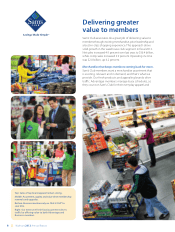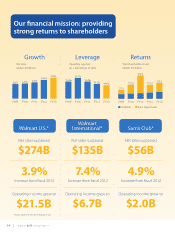Walmart 2013 Annual Report Download - page 20
Download and view the complete annual report
Please find page 20 of the 2013 Walmart annual report below. You can navigate through the pages in the report by either clicking on the pages listed below, or by using the keyword search tool below to find specific information within the annual report.18 || Walmart 2013 Annual Report
Management’s Discussion and Analysis of Financial
Condition and Results of Operations
Overview
Wal-Mart Stores, Inc. (“Walmart,” the “Company” or “we”) operates retail
stores in various formats under 69 banners around the world and is
committed to saving people money so they can live better. We earn the
trust of our customers every day by providing a broad assortment of
quality merchandise and services at everyday low prices (“EDLP”), while
fostering a culture that rewards and embraces mutual respect, integrity
and diversity. EDLP is our pricing philosophy under which we price
items at a low price every day so that our customers trust that our prices
will not change under frequent promotional activities. Our focus for
Sam’s Club is to provide exceptional value on brand name and private
label merchandise at “members only” prices for both business and
personal use. Internationally, we operate with similar philosophies.
Our scal year ends on January 31 for our United States (“U.S.”) and
Canadian operations. We consolidate all other operations generally using
a one-month lag and on a calendar basis. We discuss how the results of
our various operations are consolidated for nancial reporting purposes
in Note 1 in the “Notes to Consolidated Financial Statements.”
We intend for this discussion to provide the reader with information
that will assist in understanding our nancial statements, the changes in
certain key items in those nancial statements from year to year, and the
primary factors that accounted for those changes, as well as how certain
accounting principles a ect our nancial statements. We also discuss
certain performance metrics that management uses to assess our per-
formance. Additionally, the discussion provides information about the
nancial results of the various segments of our business to provide a
better understanding of how those segments and their results a ect the
nancial condition and results of operations of the Company as a whole.
This discussion, which presents our results for the scal years ended
January 31, 2013 (“ scal 2013”), January 31, 2012 (“ scal 2012”) and
January 31, 2011 (“ scal 2011”), should be read in conjunction with our
Consolidated Financial Statements and accompanying notes.
Our operations consist of three reportable business segments:
Walmart U.S., Walmart International and Sam’s Club. The Walmart U.S.
segment includes the Company’s mass merchant concept in the U.S.,
operating under the “Walmart” or “Wal-Mart” brand, as well as
walmart.com. The Walmart International segment consists of the
Company’s operations outside of the U.S., including various retail
websites. The Sam’s Club segment includes the warehouse membership
clubs in the U.S., as well as samsclub.com.
Our business is seasonal to a certain extent due to di erent calendar
events and national and religious holidays, as well as di erent climates.
Historically, our highest sales volume and operating income occur in
the scal quarter ending January 31.
Throughout this Management’s Discussion and Analysis of Financial
Condition and Results of Operations, we discuss segment operating
income, comparable store and club sales and other measures.
Management measures the results of its segments using, among other
measures, each segment’s operating income, including certain corporate
overhead allocations. From time to time, we revise the measurement
of each segment’s operating income or other measures, including any
corporate overhead allocations and other items impacting the measures
used to evaluate our segment’s results, as dictated by the information
regularly reviewed by our chief operating decision maker. When we do
so, the previous period amounts and balances are reclassi ed to conform
to the current period’s presentation. The amounts disclosed for “Other
unallocated” in the leverage discussion of the Company’s performance
metrics consist of corporate overhead and other items not allocated to
any of the Company’s segments.
Comparable store and club sales is a metric which indicates the
performance of our existing U.S. stores and clubs by measuring the
change in sales for such stores and clubs for a particular period from the
corresponding period in the previous year. Walmart’s de nition of
comparable store and club sales includes sales from stores and clubs
open for the previous 12 months, including remodels, relocations and
expansions, as well as sales initiated online. Changes in format are
excluded from comparable store and club sales when the conversion is
accompanied by a relocation or expansion that results in a change in
retail square feet of more than ve percent. Comparable store and club
sales are also referred to as “same-store” sales by others within the retail
industry. The method of calculating comparable store and club sales
varies across the retail industry. As a result, our calculation of comparable
store and club sales is not necessarily comparable to similarly titled
measures reported by other companies.
In discussing our operating results, the term currency exchange rates
refers to the currency exchange rates we use to convert the operating
results for all countries where the functional currency is not the U.S.
dollar. We calculate the e ect of changes in currency exchange rates as
the di erence between current period activity translated using the
current period’s currency exchange rates, and the comparable prior year
period’s currency exchange rates. Throughout our discussion, we refer
to the results of this calculation as the impact of currency exchange rate
uctuations. When we refer to constant currency operating results, this
means operating results without the impact of the currency exchange
rate uctuations and without the impact of acquisitions until the
acquisitions are included in both comparable periods. The disclosure of
constant currency amounts or results permits investors to understand
better Walmart’s underlying performance without the e ects of currency
exchange rate uctuations or acquisitions. Volatility in currency exchange
rates may impact the results, including net sales and operating income,
of the Company and the Walmart International segment in the future.
We made certain reclassi cations to prior period amounts and
balances to conform to the presentation in the current scal year. These
reclassi cations did not impact the Company’s consolidated operating
income or net income. Additionally, certain prior period segment asset
and expense allocations have been reclassi ed among segments to be
comparable with the current period presentation.
























